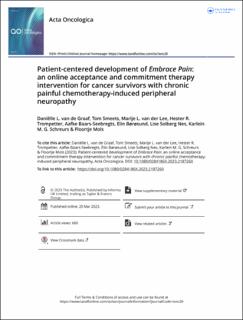| dc.contributor.author | van de Graaf, Daniëlle L | |
| dc.contributor.author | Smeets, Tom | |
| dc.contributor.author | van der Lee, Marije L. | |
| dc.contributor.author | Trompetter, Hester R. | |
| dc.contributor.author | Baars-Seebregts, Aafke | |
| dc.contributor.author | Børøsund, Elin | |
| dc.contributor.author | Nes, Lise Solberg | |
| dc.contributor.author | Schreurs, Karlein M. G. | |
| dc.contributor.author | Mols, Floortje | |
| dc.date.accessioned | 2023-07-26T12:43:19Z | |
| dc.date.available | 2023-07-26T12:43:19Z | |
| dc.date.created | 2023-03-21T16:58:30Z | |
| dc.date.issued | 2023 | |
| dc.identifier.citation | van de Graaf, D. L., Smeets, T., van der Lee, M. L., Trompetter, H. R., Baars-Seebregts, A., Børøsund, E., Solberg Nes, L., Schreurs, K. M. G. & Mols, F. (2023). Patient-centered development of Embrace Pain: an online acceptance and commitment therapy intervention for cancer survivors with chronic painful chemotherapy-induced peripheral neuropathy. Acta Oncologica, 1-13. | en_US |
| dc.identifier.issn | 0284-186X | |
| dc.identifier.uri | https://hdl.handle.net/11250/3081453 | |
| dc.description.abstract | Background: Around 30% of cancer survivors suffer from chemotherapy-induced peripheral neuropathy (CIPN) ≥6 months after completion of chemotherapy, which comes with limitations in daily functioning and worsened quality of life(QoL). Treatment options are scarce. Our aim was to develop an online self-help intervention based on Acceptance and Commitment Therapy (ACT) to reduce pain interference in cancer survivors experiencing painful chronic CIPN.
Material and methods: This article applied a patient-centered design process using the Center for eHealth Research (CeHRes) roadmap. User needs were examined using online semi-structured interviews with patients and experts (N = 23). Interviews were transcribed verbatim and analyzed using thematic analysis. Personas were created based on interviews. Intervention content was based on identified user needs and ACT. Content and design were finalized using low-fidelity prototype testing (N = 5), and high-fidelity prototype testing (N = 7).
Results: Patients appreciated and agreed with the elements of ACT, had varying guidance needs, and wanted to have autonomy (e.g., moment and duration of use). Additionally, it was important to be aware that patients have had a life-threatening disease which directly relates to the symptoms they experience. Patients reported to prefer a user-friendly and accessible intervention. Similar points also emerged in the expert interviews. The final intervention, named Embrace Pain, includes six sessions. Session content is based on psychoeducation and all ACT processes. Further interpretation of the intervention (such as quotes, guidance, and multimedia choices) is based on the interviews.
Conclusion: This development demonstrated how a patient-centered design process from a theoretical framework can be applied. Theory-driven content was used as the basis of the intervention. Findings show an online ACT intervention designed for cancer survivors with painful chronic CIPN. | en_US |
| dc.language.iso | eng | en_US |
| dc.rights | Attribution-NonCommercial-NoDerivatives 4.0 Internasjonal | * |
| dc.rights.uri | http://creativecommons.org/licenses/by-nc-nd/4.0/deed.no | * |
| dc.title | Patient-centered development of Embrace Pain: an online acceptance and commitment therapy intervention for cancer survivors with chronic painful chemotherapy-induced peripheral neuropathy | en_US |
| dc.type | Peer reviewed | en_US |
| dc.type | Journal article | en_US |
| dc.description.version | publishedVersion | en_US |
| dc.rights.holder | © 2023 The Author(s). | en_US |
| dc.source.pagenumber | 1-13 | en_US |
| dc.source.journal | Acta Oncologica | en_US |
| dc.identifier.doi | https://doi.org/10.1080/0284186X.2023.2187260 | |
| dc.identifier.cristin | 2135903 | |
| cristin.ispublished | true | |
| cristin.fulltext | original | |
| cristin.qualitycode | 1 | |

